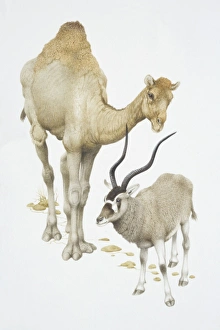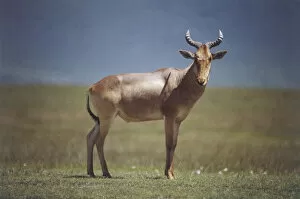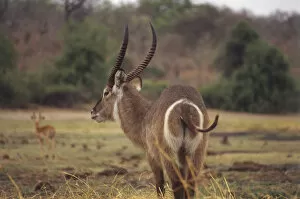Hippotraginae Collection
Roaming the vast grasslands of Africa, from the Masai Mara in Kenya to the open plains, a diverse array of antelope species thrive
All Professionally Made to Order for Quick Shipping
Roaming the vast grasslands of Africa, from the Masai Mara in Kenya to the open plains, a diverse array of antelope species thrive. The Dromedary Camel (Camelus dromedarius) and Addax (Addax nasomaculatus) may not be antelope, but their front-view silhouettes grace the African landscape. Wildebeest (Connochaetes taurinus) mother and two calves, walking side by side, graze peacefully in the open grassland. Their dark brown bodies, long dark manes, white beards, and curled horns stand out against the blue horizon. Topi (Damaliscus lunatus), with its lyrical shaped ringed horns, brown fur, and white insides of slender legs, blends seamlessly with the grasslands. The side view reveals its tail hanging down, and its direct gaze towards the camera. Water Buck (Kobus ellipsiprymnus) stands proudly, its reddish brown coat contrasting with the white ring around its rump, white beard, and large erect ears. Its long dark tail curls up as it looks towards the camera, open grassland in the background. A male Lechwe (Kobus leche), also known as a Marsh Antelope, stands in the grass, its long curved ringed horns and reddish brown body creating a striking image. The Topi (Damaliscus lunatus) poses sideways, its reddish brown body and lyrical shaped ringed horns contrasting against the open grassland and blue horizon. Its direct gaze towards the camera adds an intriguing element. Waterbuck (Kobus ellipsiprymnus) in rear view, chewing on grass, displays its long brown fur, long curved ringed horns, white ring around its rump, white beard, and short tail curling up. The open grassland stretches out in the background. Oryx gazella, the Gemsbok, and Oryx dammah, the Scimitar-horned Oryx, complete this diverse antelope lineup. Their unique features, such as their long, curved horns, and adaptability to arid environments, make them true African gems.










